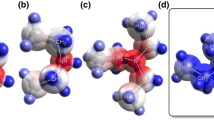Abstract
Some novel bis-(substituted-phenoxy) ended glycols were synthesised usinghydroxy aromatics of vanillin, o-vanillin, iso-vanillin and 4-hydroxy coumarin which reacted with bis-dihalides of polyglycols in the presence ofDMSO/alkali carbonate. The novel podands, Ar-(CH2CH2O)m-Ar,(m = 1–4), were identified with IR, 1H-NMR, 13C-NMR and mass spectrometry. The various (formyl-methoxy)phenyl and 4-oxycoumarin derivatives of glycols were studied to estimate the cation binding selectivity of SCN- salts ofLi+, Na+, K+ and Zn2+ cations in acetonitrile using steady statefluorescence spectroscopy. The relevant structures of podands have shown goodselectivity depending on the cation and the glycollength, although the chromophoreend groups have no specific contribution on binding.
Similar content being viewed by others
References
M.R. Truter: J. Chem. Soc. B. 1544 (1970).
F. Vögtle and E. Weber: Angew. Chem. Int. Ed. Engl. 18, 753 (1979).
F. Vögtle, W.M. Müller, W. Wehner, and E. Buhleier: Angew. Chem. Int. Ed. Engl. 16, 548 (1977).
F. Vögtle and U. Heimann: Chem. Ber. 111, 2757 (1978).
E. Weber and F. Vögtle: Tetrahedron Lett. 2415 (1975).
G. Chaput, G. Jemined, and J. Juillard: Can. J. Chem. 53, 2240 (1975).
B. Tümmler, G. Maas, E. Weber, and F. Vögtle: J. Am. Chem. Soc. 99, 4683 (1977).
B.G. Cox, J. Garsia-Rosas, and H. Schneider: J. Am. Chem. Soc. 103, 1054 (1981).
E.A. Green, W.L. Duax, G.M. Smith, and F. Wudl: J. Am. Chem. Soc. 97, 6689 (1975).
J.D.E. Davies: Chem. Edu. 54, 536 (1977).
J. Grand, P. Lazslo, W. Offermann, and P.L. Rinaldi:J. Am. Chem. Soc. 103, 1380 (1981).
B. Valeur, J. Pouget, J. Bourson, M. Kaschke, and N.P. Ernsting: J. Phys. Chem. 96, 6545 (1992).
J.D.R Thomas: Analyst. 116, 1211 (1991).
J.L Atwood, in: Y. Inoue and G.W. Gokel (eds.), Cation Binding by Macrocycles, Marcel Dekker, Basel (1990), p. 581.
N. Karslı and Ç. Erk: Dyes Pigments 32, 61 (1996)
H. Tuncer and Ç Erk: Dyes Pigments 44, 81 (2000).
A. Göçmen, M. Bulut and Ç. Erk: Pure Appl. Chem. 65, 447 (1993).
Ç. Erk, A. Göçmen and M. Bulut: J. Incl. Phenom. 37, 411 (2000).
Ç. Erk: Ind. Eng. Chem. Res. 39, 3582 (2000).
V. Ramamurthy and K.S. Shanze: In A.J. Lees, (ed.), Luminescent Metal Complexes as Spectroscopic Probes of Monomer/polymer Environments, Marcel Dekker, Basel (2001), p 209.
Author information
Authors and Affiliations
Rights and permissions
About this article
Cite this article
Tuncer, H., Erk, Ç. The Synthesis and the Cationic Fluorescence Role of Glycols with Aromatic End Groups, Part III. Journal of Inclusion Phenomena 45, 271–274 (2003). https://doi.org/10.1023/A:1024507615241
Issue Date:
DOI: https://doi.org/10.1023/A:1024507615241




